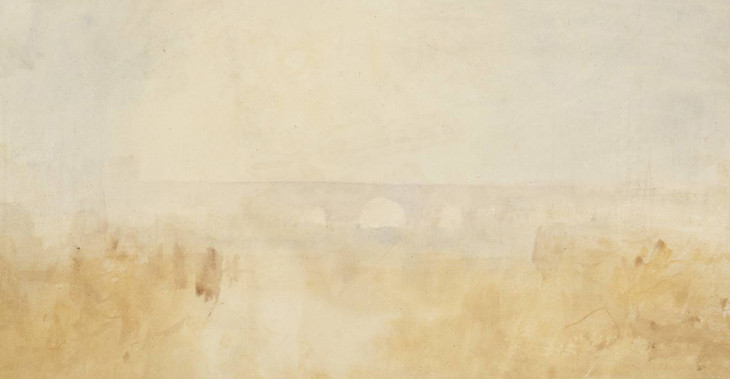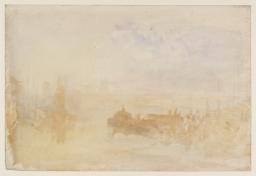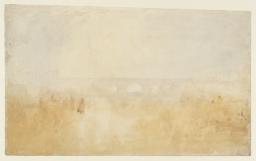From the entry
Between March 1824 and August 1831 work progressed on replacing the fundamentally medieval ‘Old’ London Bridge across the River Thames with a new structure just upstream, itself since replaced. With his interest in London, and the Thames in particular with its ever-changing aspects, Turner followed the work’s progress closely, even attending the grand ceremony of laying the foundation stone on the riverbed; he made numerous pencil sketches on that occasion and later as set out in the Introduction to the present author’s ‘Thames, London and South of England 1821–7’ section of this catalogue; see also David Blayney Brown’s ‘Thames sketchbooks c.1804–14’ section. Turner’s sketches appear to have been at least partly motivated by what Eric Shanes has called an ‘“Unknown” London Series’. In 1820, the engraver and publisher W.B. Cooke, who had commissioned work from Turner for other ...
Between March 1824 and August 1831 work progressed on replacing the fundamentally medieval ‘Old’ London Bridge across the River Thames with a new structure just upstream, itself since replaced. With his interest in London, and the Thames in particular with its ever-changing aspects, Turner followed the work’s progress closely, even attending the grand ceremony of laying the foundation stone on the riverbed; he made numerous pencil sketches on that occasion and later as set out in the Introduction to the present author’s ‘Thames, London and South of England 1821–7’ section of this catalogue; see also David Blayney Brown’s ‘Thames sketchbooks c.1804–14’ section.
Turner’s sketches appear to have been at least partly motivated by what Eric Shanes has called an ‘“Unknown” London Series’.1 In 1820, the engraver and publisher W.B. Cooke,2 who had commissioned work from Turner for other projects such as the ongoing Picturesque Views on the Southern Coast of England series (see the introduction to the ‘West Country 1811’ section),3 instigated a new series of views after Turner and his contemporaries. After a fitful start, the partwork scheme was advertised in The Repository of Arts for August 1824 as ‘Views in London and its environs’, but this coincided with the launch of rivals Hurst and Robinson’s Picturesque Views in London and its environs. Cooke abandoned his plan, only publishing a print after Turner’s The Custom House, in 1827, as noted below.4
Four completed watercolours can be linked to the scheme: View of London from Greenwich, of about 1824–5 (Metropolitan Museum of Art, New York);5 the so-called Port of London, dated 1824 (Victoria and Albert Museum, London),6 engraved in 1827 as Old London Bridge and Vicinity (Tate impression: T06070); The Tower of London, of about 1825 (private collection), engraved in 1831 for The Literary Souvenir (Tate impression: T06137);7 and The Custom House of about 1825 (Vancouver Art Gallery), engraved in 1827 (Tate impression: T06069).8
The present section is limited to two variant ‘colour beginning’ watercolour studies for the London Bridge scene, D25160 and D25291; for a discussion of the function of such works in general, see the Introduction to the ‘England and Wales Colour Studies c.1825–39’ section.9 In terms of the other designs, the panoramic Greenwich view echoes the painting London from Greenwich Park, exhibited in 1809 (Tate N00483)10 and the related composition London from Greenwich, engraved for the Liber Studiorum in 1811 (see under Tate D08131; Turner Bequest CXVII D). Catalogued elsewhere, Tate D25496 (Turner Bequest CCLXIII 373) has been linked tentatively to the Tower of London subject, but any resemblance is rather generic and perhaps fortuitous. Tate D25222 and D25294 (Turner Bequest CCLXIII 100, 172), similarly loose watercolour studies, appear to show the Custom House from a different angle, and may be undeveloped variations of the subject for Turner’s subsequent major project, the Picturesque Views in England and Wales; see also Tate D25179 (Turner Bequest CCLXIII 57).
Eric Shanes, ‘Turner’s “Unknown” London Series’, Turner Studies, vol.1, no.2, [Winter 1981], p.[36].
See Gillian Forrester, ‘Cooke, William Bernard (1778–1855)’ in Evelyn Joll, Martin Butlin and Luke Herrmann (eds.), The Oxford Companion to J.M.W. Turner, Oxford 2001, p.63.
See also Luke Herrmann, ‘Southern Coast of England, Picturesque Views of [sic] the’ in ibid., p.307.
See Eric Shanes, Turner’s England 1810–38, London 1990, p.11, summarising the comprehensive account of the scheme and its rivals set out in Shanes 1981, pp.[36]–42; see also Shanes 1990, pp.128–9, 271–2, and Ian Warrell, Turner’s Sketchbooks, London 2014, p.121.
Ibid., pp.358–9 no.516; Wilton also lists a watercolour of ‘London Docks’ (p.359 no.517) as ?1825 and perhaps the same size as the Custom House subject, ‘Provenance and whereabouts unknown’.
See also Eric Shanes, ‘Beginnings’ in Evelyn Joll, Martin Butlin and Luke Herrmann (eds.), The Oxford Companion to J.M.W. Turner, Oxford 2001, pp.21–3; among many other accounts, see also Andrew Wilton in Martin Butlin, Wilton and John Gage, Turner 1775–1851, exhibition catalogue, Royal Academy, London 1974, p.26; and Andrew Wilton, J.M.W. Turner: His Life and Work, Fribourg 1979, p.187.
How to cite
Matthew Imms, ‘Colour Studies Relating to ‘Views in London and its Environs’ c.1824’, June 2016, in David Blayney Brown (ed.), J.M.W. Turner: Sketchbooks, Drawings and Watercolours, Tate Research Publication, February 2017, https://www



